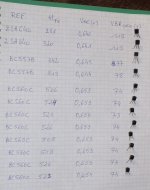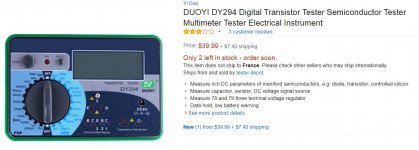The many paralleled philosophy was to achieve extreme low noise performance.
The "matching", both thermal and electrical, is simply a give away consequence.
The "matching", both thermal and electrical, is simply a give away consequence.
Really? I have only used them in logarithmic amps and VCAs, long ago, for instrumentation, where the sole attraction was supermatching, to get an order of improvement on Motorola's then log. IC amps.The many paralleled philosophy was to achieve extreme low noise performance.
The "matching", both thermal and electrical, is simply a give away consequence.
Just reviewing early Natsemi app. notes AN262 onward, I'm reminded that you don't see early audio apps for the LM394 so you may appreciate my different viewpoint, low noise instrumentation requirements notwithstanding.
Audio use is another matter, I guess, as they did get thrown into the front end of preamps and amps everywhere - only to be dropped a couple of models later, hardly seen since.
The NF is certainly low at 1nV/root Hz but no better than single transistor pairs in MAT02, SSM2210 etc. I have tended to think the low noise is a consequence of multiple transistors rather than my principal requirement of gain matching and low drift. When I eventually began to experiment with them in audio, the priority was LTP DC balance and NF was not particularly important, as we find in most commercial amplifiers.
Really? I have only used them in logarithmic amps and VCAs, long ago, for instrumentation, where the sole attraction was supermatching, to get an order of improvement on Motorola's then log. IC amps.
Just reviewing early Natsemi app. notes AN262 onward, I'm reminded that you don't see early audio apps for the LM394 so you may appreciate my different viewpoint, low noise instrumentation requirements notwithstanding.
Audio use is another matter, I guess, as they did get thrown into the front end of preamps and amps everywhere - only to be dropped a couple of models later, hardly seen since.
The NF is certainly low at 1nV/root Hz but no better than single transistor pairs in MAT02, SSM2210 etc. I have tended to think the low noise is a consequence of multiple transistors rather than my principal requirement of gain matching and low drift. When I eventually began to experiment with them in audio, the priority was LTP DC balance and NF was not particularly important, as we find in most commercial amplifiers.
http://www.johnhardyco.com/pdf/990.pdf
Hi, sorry for bringing up so old post, but I have similar question. Can anyone point to PNP alternative for such devices as 2sd2165, 2sd2544?
Hello,
I made measurements on some of my transistors.
I used a PeakMeter PM8233D DVM to measure Vbe, whilst measuring
Hfe with a Duoyi DY294 transistor tester, @ Ib = 10µA.
The 2SA640 were LTP extracted from an old power amplifier.
I don't remenber the brand.
The BC557B and BC560C were baught from an eBay chinese seller.
They were presented as matched transistors.
So ??
I made measurements on some of my transistors.
I used a PeakMeter PM8233D DVM to measure Vbe, whilst measuring
Hfe with a Duoyi DY294 transistor tester, @ Ib = 10µA.
The 2SA640 were LTP extracted from an old power amplifier.
I don't remenber the brand.
The BC557B and BC560C were baught from an eBay chinese seller.
They were presented as matched transistors.
So ??
Attachments
what are the digits that look like an inverted "V"?Hello,
I made measurements on some of my transistors.
I used a PeakMeter PM8233D DVM to measure Vbe, whilst measuring
Hfe with a Duoyi DY294 transistor tester, @ Ib = 10µA.
The 2SA640 were LTP extracted from an old power amplifier.
I don't remenber the brand.
The BC557B and BC560C were baught from an eBay chinese seller.
They were presented as matched transistors.
So ??
How did you measure VBR ce0?
Hello,
"what are the digits that look like an inverted "V"?" It's Volt.
"How did you measure VBR ce0?"
With the transistor tester Duoyi DY294.
- Review of the DY294 Digital Transistor Tester-Part 1 | Electronics Repair And Technology News
"what are the digits that look like an inverted "V"?" It's Volt.
"How did you measure VBR ce0?"
With the transistor tester Duoyi DY294.
- Review of the DY294 Digital Transistor Tester-Part 1 | Electronics Repair And Technology News
Attachments
Last edited:
Number 1 European style.what are the digits that look like an inverted "V"?
Number 1 European style.
Ahh! That's why I didn't recognize any abnormalities in the picture 😛!
Best regards!
I haven't bought any in a while, but it seems like very professional here.
======================
YIY — Inverter / Voltage Stabilizer Professional Manufacturer!
======================
YIY — Inverter / Voltage Stabilizer Professional Manufacturer!
Hello,
Right, I didn't understand your question !
The way you wrote "1" is like inverted "V". I had no problem reading it even tho I didn't know about any European style.
I don't know why you made the test, as BC550c/560c is pretty standard low noise high gain (typically above 500) transistors, and OP seemed to want something better than that.
BUT, important information from your test is that they actually have such a high break down point!! (74v?). I have also believed that the rated max SOA characteristics in the datasheets are underrated for original products from top manufacturers. That's why I use Vceo=45V device all over the places.
I found that BC560C s of Fairchild semi that have Hfe a bit lower than genuine ON Semi on last time. I dont know exactly reason why.
Hfe parameter is performed by low cost transistor tester kits that are commonly selling on Ebay.
Hfe parameter is performed by low cost transistor tester kits that are commonly selling on Ebay.
C grade is the highest grade having hfe from 420 to 800. It is normal that some manufacturers produce typically lower than others. It is also often found that once in a while ON semi can perform better than the published maximum (in this case 800)
sir what is good replacement for 2SA1240 thank you so much sirI don't think so. LM394 is a multiple transistor, with many parallel transistors formed on the one substrate to achieve otherwise impossible matching by virtue of averaging the individual junction properties.
You won't get anywhere near that match quality or low drift without extremely precise matching of duals, also on the same substrate. Then again, if you don't really need the "supermatch" properties, you may find these useful, if also obsolete: Page Not Found | Analog Devices
Page Not Found | Analog Devices
You can still obtain LM394H if necessary - there are a few realistic opportunities on the net with a little help from Google. However, this recently revised doc. by TI suggests some renewed manufacturing interest: http://www.ti.com/lit/an/snoa626b/snoa626b.pdf
If you can't find the real deal, they're basically two ECB pinout transistors side by side - you could epoxy together two KSA992 or similar to obtain the desired pinout (or maybe solder in first, then epoxy). Much like what people are doing to replace 2SA798s, except easier. Should the whole thing get too thick, you could probably sand off some of the rounded back.sir what is good replacement for 2SA1240 thank you so much sir
- Home
- Amplifiers
- Solid State
- Very High-Gain PNP Transistors...

